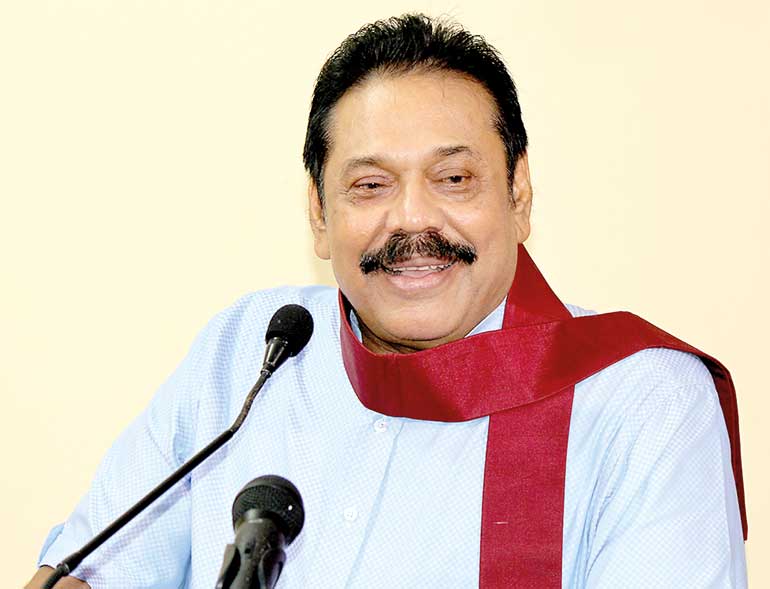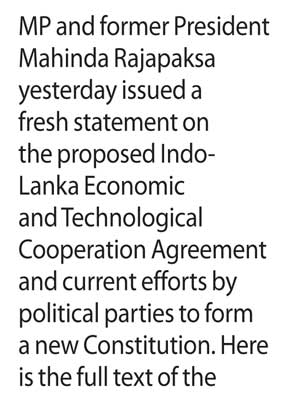Monday Mar 17, 2025
Monday Mar 17, 2025
Thursday, 31 March 2016 00:00 - - {{hitsCtrl.values.hits}}

Former President Mahinda Rajapaksa
 In a TV discussion broadcast last Sunday, the President publicly endorsed the proposed Economic and Technological Cooperation Agreement (ETCA) with India. All members of the SLFP serving in the Government will now have to make a very personal decision as to where they stand on this matter which will have far-reaching consequences for Sri Lanka.
In a TV discussion broadcast last Sunday, the President publicly endorsed the proposed Economic and Technological Cooperation Agreement (ETCA) with India. All members of the SLFP serving in the Government will now have to make a very personal decision as to where they stand on this matter which will have far-reaching consequences for Sri Lanka.
When the President said that it was the ‘old Government’ (parana anduwa) that had started negotiations for the CEPA with India, he was not referring to my Government. CEPA was initiated in 2002 under the previous UNP Government led by Mr. Ranil Wickremesinghe. My Government did not take the CEPA negotiations forward due to the misgivings expressed by wide sections of society.
Though Indian exports flow into Sri Lanka without any obstruction under the existing Free Trade Agreement, Sri Lankan exports to India have come up against various impediments such as quantity limitations, licensing requirements, non-acceptance of Sri Lankan product certification and State taxes at the Indian end. Our suggestion to the present Government is that such outstanding issues be sorted out to enable Sri Lanka to obtain the due benefit under the existing FTA before the trade relationship is taken to the next level.
ETCA envisages a trade in services as well as goods. Sri Lankan professional associations have warned that the mismatch between the regulatory frameworks for professions in India and Sri Lanka will result in Indian professionals gaining unrestricted access to the Sri Lankan market while Sri Lankan professionals are shut out of the Indian market in a repetition of what has happened in the trade in goods.
It is the height of irresponsibility to sign an ETCA ‘framework’ agreement leaving the specific details to be negotiated later when there are so many unresolved trade issues between the two countries. In justifying his endorsement of the ETCA with India, the President observed that while some people in the SLFP spoke highly of the manner in which Mrs. Sirima Bandaranaike maintained close relations with Mrs. Indira Gandhi, the same individuals were against the present Government maintaining a similar relationship with Prime Minister Modi.
We should bear in mind that though Mrs. Sirima Bandaranaiake and her son Anura were personally very close to Rajiv Gandhi, neither of them supported the 1987 Indo-Lanka Peace Accord. We should be guided in such matters by considerations of the national interest.
Speaking of constitutional change during his TV interview, the President stressed the need to give priority to solve the problems of the Tamil people. The Prime Minister also now speaks of the need to devolve power. However the single most important slogan in the ‘yahapalana’ campaign was the abolition of the executive presidency with electoral reform coming next.
Hence I stress once again that constitutional reform should focus on abolishing the executive presidency and bringing about electoral reform. More contentious matters such as the devolution of power can be dealt with later. The yahapalana Government should respect the public opinion that they themselves helped create.
In response to a previous statement I made on foreign loans, the Finance Minister has been repeatedly telling the media that though I had said that the Mattala Airport and Hambantota Harbour cost $ 190 million and $ 426 million respectively, the records of the Government indicated expenditure of $ 210 million and $ 1,300 million and that the difference has not been explained.
The total cost of the Mattala airport was $ 210 million with the loan from the China Exim Bank amounting to $ 190 million. The rest was the ‘local component’ of the project paid by the Government of Sri Lanka. We mentioned only the loan component in our previous statement because we were speaking on the subject of foreign loans.
The Hambantota Harbour Phase I cost $ 501 million and the 15% local component was met by the Ports Authority. The foreign loan component was something like $ 426 million. When the Finance Minister says that the cost of the Hambantota Port was over $ 1,300 million, he has included the cost of the $ 808 million second phase which commenced in 2012 and is still under construction.
Two other ministers admitted publicly that the Government had indeed taken foreign loans amounting to more than $ 6,361 million since March 2015 as we said in our previous statement, but they said that all these loans had to be taken in order to pay off the loans taken at high interest rates by my Government.
The project loans taken by my Government were long-term credit at an interest rate of 2% or less. The Government borrowed $ 375 million through a development bond issue a few days ago. This, combined with the three-month $ 700 million currency swap announced by India yesterday, brings the total foreign borrowings of this Government from March 2015 to March 2016 to $ 7,436 million. Of this amount around half – $ 3,298 million – falls due in 2016.
The present crisis is due to the haphazard and irresponsible foreign borrowings of the present Government and not due to any loans taken by previous governments.
Discover Kapruka, the leading online shopping platform in Sri Lanka, where you can conveniently send Gifts and Flowers to your loved ones for any event including Valentine ’s Day. Explore a wide range of popular Shopping Categories on Kapruka, including Toys, Groceries, Electronics, Birthday Cakes, Fruits, Chocolates, Flower Bouquets, Clothing, Watches, Lingerie, Gift Sets and Jewellery. Also if you’re interested in selling with Kapruka, Partner Central by Kapruka is the best solution to start with. Moreover, through Kapruka Global Shop, you can also enjoy the convenience of purchasing products from renowned platforms like Amazon and eBay and have them delivered to Sri Lanka.
Discover Kapruka, the leading online shopping platform in Sri Lanka, where you can conveniently send Gifts and Flowers to your loved ones for any event including Valentine ’s Day. Explore a wide range of popular Shopping Categories on Kapruka, including Toys, Groceries, Electronics, Birthday Cakes, Fruits, Chocolates, Flower Bouquets, Clothing, Watches, Lingerie, Gift Sets and Jewellery. Also if you’re interested in selling with Kapruka, Partner Central by Kapruka is the best solution to start with. Moreover, through Kapruka Global Shop, you can also enjoy the convenience of purchasing products from renowned platforms like Amazon and eBay and have them delivered to Sri Lanka.